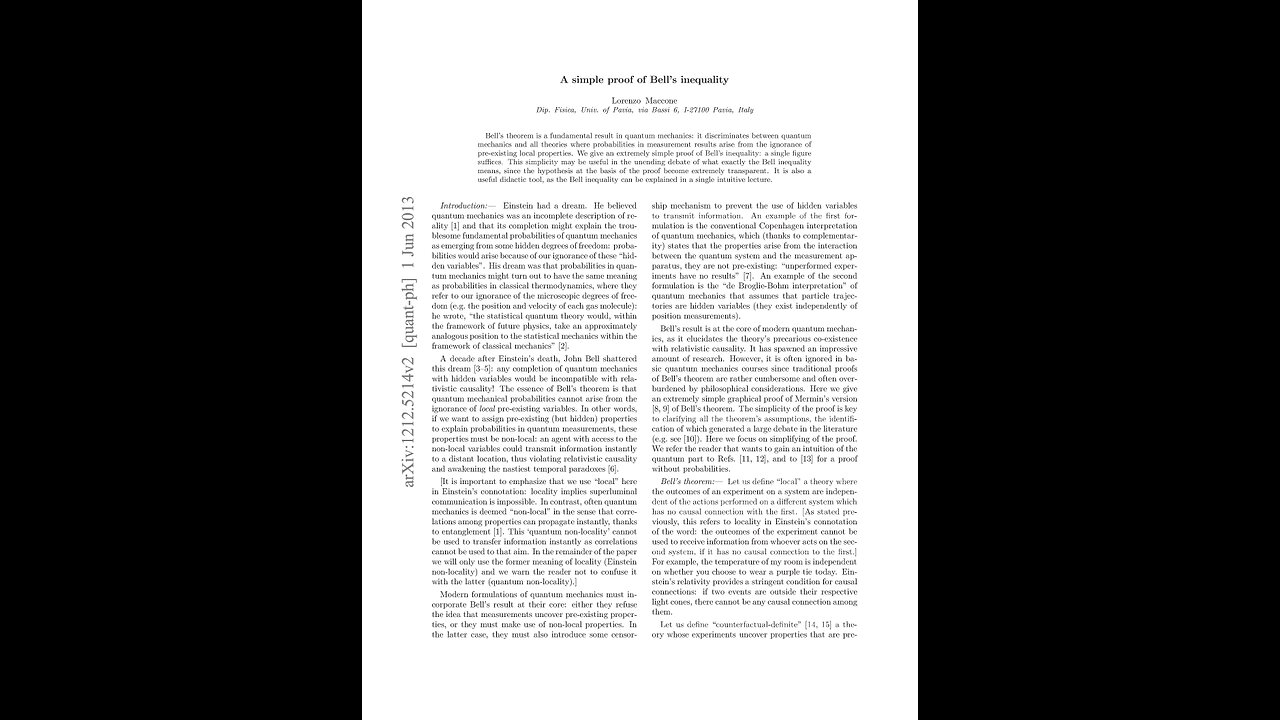Premium Only Content

A simple proof of Bell’s inequality. Lorenzo Maccone. A Puke (TM) Audiopaper
A simple proof of Bell’s inequality.
Lorenzo Maccone.
Dip. Fisica, University of Pavia, via Bassi 6, I-27100 Pavia, Italy
Bell’s theorem is a fundamental result in quantum mechanics: it discriminates between quantum mechanics and all theories where probabilities in measurement results arise from the ignorance of pre-existing local properties. We give an extremely simple proof of Bell’s inequality: a single figure suffices. This simplicity may be useful in the unending debate of what exactly the Bell inequality means, since the hypothesis at the basis of the proof become extremely transparent. It is also a useful didactic tool, as the Bell inequality can be explained in a single intuitive lecture.
Introduction: Einstein had a dream. He believed quantum mechanics was an incomplete description of reality and that its completion might explain the troublesome fundamental probabilities of quantum mechanics as emerging from some hidden degrees of freedom: probabilities would arise because of our ignorance of these “hidden variables”. His dream was that probabilities in quantum mechanics might turn out to have the same meaning as probabilities in classical thermodynamics, where they refer to our ignorance of the microscopic degrees of freedom (e.g. the position and velocity of each gas molecule): he wrote, “the statistical quantum theory would, within the framework of future physics, take an approximately analogous position to the statistical mechanics within the framework of classical mechanics”.
A decade after Einstein’s death, John Bell shattered this dream: any completion of quantum mechanics with hidden variables would be incompatible with relativistic causality! The essence of Bell’s theorem is that quantum mechanical probabilities cannot arise from the ignorance of local pre-existing variables. In other words, if we want to assign pre-existing (but hidden) properties to explain probabilities in quantum measurements, these properties must be non-local: an agent with access to the non-local variables could transmit information instantly to a distant location, thus violating relativistic causality and awakening the nastiest temporal paradoxes.
It is important to emphasize that we use “local” here in Einstein’s connotation: locality implies superluminal communication is impossible. In contrast, often quantum mechanics is deemed “non-local” in the sense that correlations among properties can propagate instantly, thanks to entanglement. This ‘quantum non-locality’ cannot be used to transfer information instantly as correlations cannot be used to that aim. In the remainder of the paper we will only use the former meaning of locality, Einstein non-locality and we warn the reader not to confuse it with the latter, quantum non-locality.
Modern formulations of quantum mechanics must incorporate Bell’s result at their core: either they refuse the idea that measurements uncover pre-existing properties, or they must make use of non-local properties. In the latter case, they must also introduce some censorship mechanism to prevent the use of hidden variables to transmit information. An example of the first formulation is the conventional Copenhagen interpretation of quantum mechanics, which, thanks to complementarity, states that the properties arise from the interaction between the quantum system and the measurement apparatus, they are not pre-existing: “unperformed experiments have no results”. An example of the second formulation is the “de Broglie-Bohm interpretation” of quantum mechanics that assumes that particle trajectories are hidden variables, they exist independently of position measurements.
Bell’s result is at the core of modern quantum mechanics, as it elucidates the theory’s precarious co-existence with relativistic causality. It has spawned an impressive amount of research. However, it is often ignored in basic quantum mechanics courses since traditional proofs of Bell’s theorem are rather cumbersome and often over-burdened by philosophical considerations. Here we give an extremely simple graphical proof of Mermin’s version of Bell’s theorem. The simplicity of the proof is key to clarifying all the theorem’s assumptions, the identification of which generated a large debate in the literature. Here we focus on simplifying of the proof.
Bell’s theorem: Let us define “local” a theory where the outcomes of an experiment on a system are independent of the actions performed on a different system which has no causal connection with the first. As stated previously, this refers to locality in Einstein’s connotation of the word: the outcomes of the experiment cannot be used to receive information from whoever acts on the second system, if it has no causal connection to the first.
For example, the temperature of my room is independent on whether you choose to wear a purple tie today. Einstein’s relativity provides a stringent condition for causal connections: if two events are outside their respective light cones, there cannot be any causal connection among them.
Page Two:
Let us define “counterfactual-definite” a theory whose experiments uncover properties that are pre-existing. In other words, in a counterfactual-definite theory it is meaningful to assign a property to a system, e.g. the position of an electron, independently of whether the measurement of such property is carried out. Sometime this counterfactual definiteness property is also called “realism”, but it is best to avoid such philosophically laden term to avoid misconceptions.
Bell’s theorem can be phrased as “quantum mechanics cannot be both local and counterfactual-definite”. A logically equivalent way of stating it is “quantum mechanics is either non-local or non counterfactual-definite”.
To prove this theorem, Bell provided an inequality (referring to correlations of measurement results) that is satisfied by all theories that are both local and counterfactual-definite. He then showed that quantum mechanics violates this inequality, and hence cannot be local and counterfactual-definite.
It is important to note that the Bell inequality can be derived also using weaker hypotheses than “Einstein locality” and “counterfactual definiteness”: such a proof is presented in Appendix A, where Einstein locality is relaxed to “Bell locality” and counterfactual definiteness is relaxed to “hidden variable models”. However, from a physical point of view, the big impact of Bell’s theorem is to prove the incompatibility of quantum mechanics with local counterfactual-definite properties, and we will stick to these hypotheses in the main text, see also Appendix B for a schematic formalization of all these results.
A couple of additional hypothesis at the basis of Bell’s theorem are often left implicit:
(1) our choice of which experiment to perform must be independent of the properties of the object to be measured, technically, “freedom of choice” or “no super-determinism”, meaning for example, if we decided to measure the color of red objects only, we would falsely conclude that all objects are red.
(2) future outcomes of the experiment must not influence which apparatus settings were previously chosen, whereas clearly the apparatus settings will influence the outcomes. A trivial causality requirement, technically, “measurement independence”. These two hypothesis are usually left implicit because science would be impossible without them.
All experiments performed to date have shown that Bell inequalities are violated, suggesting that our world cannot be both local and counterfactual definite. However, it should be noted that no experiment up to now has been able to test Bell inequalities rigorously, because additional assumptions are required to take care of experimental imperfections. These assumptions are all quite reasonable, so that only conspiratorial alternatives to quantum mechanics have yet to be ruled out, where experimental imperfections are fine-tuned to the properties of the objects, namely they violate the “freedom of choice”). In the next couple of years the definitive Bell inequality experiment will be performed: many research groups worldwide are actively pursuing it.
Figure one. Proof of Bell inequality using areas to represent probabilities. In Panel “A”, the dashed area represents the probability that property Alpha of the first object and Beta of the second are equal, either they are both one or both zero. P same (Alpha, Beta).
The white area represents the probability that they are different: P different (Alpha, Beta).
The whole circle has area one equals P same (Alpha, Beta) plus P different (Alpha, Beta).
In panel “B” the gray area represents the probability that Alpha and Gamma are equal, and the non-gray area represents the probability that Alpha and Gamma are different.
If Alpha of the first object is different from both Beta and Gamma of the second, dotted area, then Beta and Gamma of the second object must be the same. Hence, the probability that Beta and Gama are the same must be larger than, or equal to, the dotted area: since Beta is the same for the two objects, P same (Beta, Gamma) must be larger than, or equal to, the dotted area.
Panel “C”, the quantity P same (Alpha, Beta) plus P same (Alpha, Gamma) plus P same (Beta, Gamma) is hence larger than, or equal to, the sum of the dashed plus gray plus dotted areas, which is in turn larger than, or equal to, the full circle of area 1. This proves the Bell inequality.
Note One. The reasoning fails if we do not employ counterfactual definite properties, for example if complementarity prevents us from assigning values to both properties Beta and Gamma of the second object. It also fails if we employ non-local properties, for example if a measurement of Beta on an object to find its value changes the value of Alpha of the other object.
Proof of Bell’s theorem: We use the Bell inequality proposed by Preskill, following Mermin’s suggestion. Suppose we have two identical objects, namely they have the same properties. Suppose also that these properties are predetermined, counterfactual definiteness, and not generated by their measurement, and that the determination of the properties of one object will not influence any property of the other object, locality.
We will only need three properties Alpha, Beta, and Gamma that can each take two values: “0” and “1”. For example, if the objects are coins, then Alpha equals zero might mean that the coin is gold and Alpha equals one that the coin is copper. Property Alpha, material. Beta equals zero means the coin is shiny and Beta equals one that it is dull. Property Beta, texture. And Gamma equals zero means the coin is large and Gamma equals one it is small. Property Gamma, size.
Suppose I do not know the properties because the two coins are a gift in two wrapped boxes: I only know the gift is two identical coins, but I do not know whether they are two gold, shiny, small coins.
Page Three:
Alpha equals zero, Beta equals zero, Gamma equals one.
Or two copper, shiny, large coins (1, 0, 0) or two gold, dull, large coins (1, 1, 0), and so on. I do know that the properties “exist”, namely, they are counterfactual-definite and pre-determined even if I cannot see them directly, and they are local, namely, acting on one box will not change any property of the coin in the other box: the properties refer separately to each coin. These are quite reasonable assumptions for two coins! My ignorance of the properties is expressed through probabilities that represent either my expectation of finding a property, Bayesian view, or the result of performing many repeated experiments with boxes and coins and averaging over some possibly hidden variable, typically indicated with the letter lambda, that determines the property, the frequentist view. For example, I might say the gift bearer will give me two gold coins with a 20 percent probability. He is stingy, but not always.
Bell’s inequality refers to the correlation among measurement outcomes of the properties: call P same (Alpha, Beta) the probability that the properties Alpha of the first object and Beta of the second are the same: Alpha and Beta are both 0, the first coin is gold and the second is shiny, or they are both 1, the first is copper and the second is dull.
For example, P same (Alpha, Beta) equals a half tells me that with 50 percent% chance Alpha equals Beta, namely they are both either zero 0 or both one. Since the two coins have equal counterfactual-definite properties, this also implies that with 50 percent chance I get two gold shiny coins or two copper dull coins. Note that the fact that the two coins have the same properties means that
P same (Alpha, Alpha) equals P same (Beta, Beta) equals P same (Gamma, Gamma) equals one. If one is made of gold, also the other one will be, or if one is made of copper, also the other one will be, and so on.
Bell’s inequality. Under the conditions that three arbitrary two-valued properties Alpha, Beta or Gamma satisfy counter-factual definiteness and locality, and that P same (X, X) equals 1 for X equals Alpha, Beta or Gamma. This means that the two objects have same properties, the following inequality among correlations holds,
P same (Alpha, Beta) plus P same (Alpha, Gama) plus P same (Beta, Gamma) is greater than, or equal to one, equation one.
Namely, a Bell inequality. The proof of such inequality is given graphically in Figure one. The inequality basically says that the sum of the probabilities that the two properties are the same if I consider respectively Alpha and Beta, Alpha and Gamma, and Beta and Gamma must be larger than one. This is intuitively clear: since the two coins have the same properties, the sum of the probabilities that the coins are gold and shiny, copper and dull, gold and large, copper and small, shiny and small, dull and large is greater than one: all the combinations have been counted, possibly more than once.
In Figure two the events to which the probabilities represented by the Venn diagrams of Figure one refer are made explicit.
This is true, of course, only if the two objects have same counterfactual-definite properties and the measurement of one does not affect the outcome of the other.
Figure Two: Explicit depiction of the properties whose probabilities are represented by the areas of the Venn diagrams in figure one. The properties are represented by a triplet of numbers, Alpha, Beta, Gamma, that indicate the counterfactual-definite, local values of the properties Alpha, Beta, and Gamma for both objects. Note that in the dotted area Alpha must be different from both Beta and Gamma, so that Beta and Gamma must be equal there. Beta and Gamma are equal also in the intersection between the two smaller sets, but that is irrelevant to the proof.
If we lack counterfactual-definite properties, we cannot infer that the first coin is shiny only because we measured the second to be shiny, even if we know that the two coins have the same properties: without counterfactual definiteness, we cannot even speak of the first coin’s texture unless we measure it. Moreover, if a measurement of the second coin’s texture can change the one of the first coin, non-locality, again we cannot infer the first coin’s texture from a measurement of the second: even if we know that the initial texture of the coins was the same, the measurement on the second may change such property of the first. Both the “counterfactual definiteness” and the “Einstein locality” hypotheses we used here can be relaxed somewhat, as shown in Appendix “A” suggested only to more advanced readers.
To prove Bell’s theorem, we now provide a quantum system that violates the above inequality. Consider two two-level systems, qubits, in the joint entangled state:
Phi plus equals zero, zero plus one, one over square root of two, and consider the two-valued properties Alpha, Beta, and Gamma obtained by projecting the qubit on the states, equation two:
Alpha is composed of two states alpha zero and alpha one, is alpha zero which is the zero state, alpha one which is the one state.
Beta is beta zero which is one half the zero state, plus square root three over two times the one state.
And beta one which is square root three over two times the zero state, plus one half the one state.
And Gamma is Gamma zero, and gamma one, similar combinations of normalized states
Where gamma zero equals a half times the zero state minus square root of three over two times the one state.
And gamma one equals square root of three over two times the zero state plus a half times the one state.
Where it is easy to check that beta one is orthogonal to beta zero and gamma one is orthogonal to gamma one.
Since the state zero and one are orthonormal this is, the inner product of state zero and state zero is one, and the inner product of state one and state one is one. And the product of the zero state and the one state is zero.
The inner product of the states b zero and b one is:
A half times square root of three over two times the magnitude of the state zero.
Plus square root f thee over two times minus a half, times the magnitude of state one.
Which is the square root of thee over four minus the square root of three over four, which is zero.
Unfortunately it is common to talk of states being composed of states in quantum mechanics, and this can often lead to confusion. It is seldom made explicit that a compound state is composed of sub states, and it is merely implied. In figure two point one, consider the system of a switch being in the configuration of open, meaning zero, or closed, meaning one. The system is in the state of zero, or one. A compound system of two switches can be formed, or new state, where the individual components are open or closed, which is equivalent to zero or one. Alternatively, the system could be composed of spinning magnets with a North or South Pole, or units of electrical charge, or standing vibrational waves in a crystal, or anything two which a label of zero or one can be given. And, as usual, the entire ensemble configuration is typically referred to, with profound indifference to communicability, as some state, which is in some state, written with a Greek letter psi. If the reader is familiar with the animated series the “Smurfs” this will all be completely clear.
Page Four:
It is also easy to check that the state Phi plus can be written in terms of the states Alpha, Beta or Gamma, equation three.
So that the two qubits have the same properties, namely P same (Alpha, Alpha) equals P same (Beta, Beta) equals P same (Gamma, Gamma) equals one.
The measurement of the same property on both qubits always yields the same outcome, either both 0 or both 1.
We are now ready to calculate the quantity on the left of Bell’s inequality, equation one. Just write the state Phi plus in terms of the eigenstates of the properties Alpha, Beta and Gamma.
For example, writing Phi plus as alpha zero, alpha zero plus alpha one, alpha one, all over square root of two, and calculating its inner product Phi plus transpose phi plus, we obtain:
Alpha zero, alpha zero transpose on alpha zero, alpha zero, plus beta zero, beta zero transposed on beta zero, beta zero, all over two, since the square root of two time the square root of two is two.
Which is one plus one over two, equals one, or P same (Alpha, Alpha) equals one.
Note that the state zero is equivalent to one half of the sum of b zero plus square root thee b one.
And the state one is equal to a half of the difference of square root of three b zero minus b one.
Substituting into the definition of Phi plus, it is easy to find the value of P same (Alpha, Beta) if we write:
Phi plus in terms of alpha zero, alpha one, and beta zero, beta one.
In fact, the probability of obtaining zero for both properties is the square modulus of the coefficient of alpha zero, beta zero, namely one eighth while the probability of obtaining one for both is the square modulus of the coefficient of alpha one, beta one, again one eighth. Hence, P same (Alpha, Beta) equals one eighth plus one eighth equals one quarter.
Analogously, we find that P same (Alpha, gamma) equals a quarter and that P same (Beta, Gamma) equals a quarter by expressing the state as Phi plus in terms of alpha, and gamma and finding its inner product with Phi plus expressed in terms of beta and gamma.
Summarizing, we have found:
P same (Alpha, Beta) plus P same (Alpha, Gamma) plus P same (Beta, Gamma) equals three quarters, which is less than one, equation four.
And this violates Bell’s inequality of equation one.
This proves Bell’s theorem: all theories that are both local and counterfactual-definite must satisfy inequality one which is violated by quantum mechanics. Then, quantum mechanics cannot be a local counterfactual- definite theory: it must either be non-counterfactual-definite, as in the Copenhagen interpretation, or non-local, as in the de Broglie-Bohm interpretation.
APPENDIX “A.”
Hidden variable models.
This appendix is addressed only to more advanced readers. In the spirit of the original proof of Bell’s theorem, one can relax both the “counterfactual definiteness” and the “Einstein locality” hypotheses somewhat. In fact, instead of supposing that there are some pre-existing properties of the objects (counterfactual definiteness), we can suppose that the properties are not completely pre- determined, but that a hidden variable lambda exists and the properties have a probability distribution that is a function of lambda.
The “hidden variable model” hypothesis is weaker than counterfactual definiteness: if the properties are pre-existing, then their probability distribution in lambda is trivial: there is a value of lambda that determines uniquely the property, for example a value lambda zero such that the probability
P, i (“A” equals zero, given Alpha, lambda zero) equals one and hence P, i (“A” equals one, given Alpha, lambda zero) equals zero, namely it is certain that property Alpha for object i has value “A” equals zero for lambda equals lambda zero.
We can also relax the “Einstein locality” hypothesis, by simply requiring that the probability distributions of measurement outcomes factorize, referred to as “Bell locality”.
Call P (of x, x prime given capital X, capital X prime, lambda the probability distribution, due to the hidden variable model, that the measurement of the property capital X on the first object gives result x and the measurement of capital prime on the second gives x prime, where Capital X, X prime equals Alpha, Beta, Gamma denote the three two-valued properties Alpha, Beta, and Gamma. By definition, “Bell locality” is the property that the probability distributions of the properties of the two objects factorize, namely equation five:
Probability of x, x prime, given Capital X, capital X prime, lambda equals
P one x, given capital X, lambda, p two, x prime, capital x prime, lambda.
The factorization of the probability means that the probability of seeing some value x of the property capital X for object one is independent of which property capital X prime one chooses to measure and what result x prime obtained on object two, and vice versa.
The “Bell locality” condition, equation five, is implied by and, hence, it is weaker than, Einstein locality.
In fact, Einstein locality implies that the measurement outcomes at one system cannot be influenced by the choice of which property is measured on a second, distant, system. So, the probability of the outcomes of the first system P one must be independent of the choice of the measured property of the second system capital X prime, namely:
P one (x, give Capital X, X prime, lambda) equals P one of x, five capital X, lambda).
The same reasoning applies to the second system, which leads to condition (5).
We now show that a Bell-local, hidden variable model together with the request that the two systems can have identical properties, implies counterfactual definiteness. This means that we can replace “counter-factual definiteness” with “hidden variable model” in the above proof of Bell theorem, which, with these relaxed hypothesis states that “no local hidden variable model can represent quantum mechanics”.
If two objects have the same property, then P same (capital X, capital X) equals one, namely the probability that a measurement of the same property X on the two objects gives opposite results, say, x equals one and x prime equals zero, is null.
In formulas, equation six, the sum over lambda of Probability of x equals one, x prime equals zero, given Capital X, capital X, lambda times p (Of lambda) equals zero.
Where the sum over lambda emphasizes that we are averaging over the hidden variables, since they are hidden, and p of lambda is the probability distribution of the hidden variable lambda in the initial joint state of the two systems.
Note that in Equation six we are measuring the same property capital X on both objects but we are looking for the probability of obtaining opposite results x prime not equals to x.
Using the Bell locality condition of equation five the probability factorizes, namely Equation six becomes equation seven:
The sum over lambda of P one of x equals one, given Capital X, lambda times P two of x prime equals zero, given Capital X, lambda times p (Of lambda) equals zero.
Since P one, P two, and p, are probabilities, they must be positive. Consider the values of lambda for which p of lambda) is greater than zero. The above sum can be null only if either P one or P two is null.
Page Five:
Namely if P one (x equals one, given| Capital X, lambda) equals zero, which implies that X has the predetermined value x equals zero, or if P two (x prime equals zero, Capital X, lambda equals zero, which means that capital X has predetermined value x prime equals zero.
We remind the reader that counterfactual definiteness means that P I (of x, give capital X, lambda) is either zero or one. It is equal to 0 if the property capital X of object i does not have the value x, and it is equal to 1 if it does have the value x.
We have, hence, shown that Equation seven implies counterfactual definiteness for property X: its value is predetermined for one of the two objects.
Summarizing, if we assume that a Bell-local hidden variable model admits two objects that have the same values of their properties, then we can prove counter- factual definiteness. This means that we can relax the “counterfactual definiteness” and “Einstein locality” hypotheses in the proof of the Bell theorem, replacing it with the “existence of a hidden variable model” and with “Bell locality” respectively, so that the Bell theorem takes the meaning that “no Bell-local hidden variable model can describe quantum mechanics”, the hypothesis that two objects can have the same values for the properties is implicit in the fact that such objects exist in quantum mechanics, see Equation three. Namely, if we want to use a hidden variable model to describe quantum mechanics, as in the de Broglie-Bohm interpretation, such model must violate Bell locality. Otherwise, if we want to maintain Bell locality, we cannot use a hidden variable model, as in the Copenhagen interpretation.
APPENDIX B: Summary of the hypotheses used and logic formalization of Bell’s theorem: We have given two different proofs of the Bell inequality based on different hypotheses. In this appendix we summarize the logic behind the Bell inequality proofs.
Hypotheses we used, rigorously defined above.
(A) “Counterfactual Definiteness”.
(B) “Einstein locality”.
(C) “No super-determinism”
(D) “Measurement independence”
(A’) “Hidden variable model”, implied by (A) and by the fact that systems with same properties exist
(see Appendix A).
(B’) “Bell locality”, implied by (B) (see Appendix A).
In the main text we have proven (Fig. 1) the following theorem:
(A) AND (B) AND (C) AND (D) therefore Bell inequality, therefore NOT QM, where with “NOT QM” we mean that quantum mechanics (QM) violates the Bell inequality and is, hence, incompatible with it. Using the fact that “X AND Y implies NOT Z” is equivalent to “Z implies NOT X OR NOT Y” (modus tollens), we can state the above theorem equivalently as QM implies NOT (A) OR NOT (B) OR NOT (C) OR NOT (D).
Since one typically assumes that both (C) and (D) are true, they can be dropped and the theorem can be written more compactly as QM implies NOT (A) OR NOT (B).
Namely, assuming “no super-determinism” and “measurement independence”, quantum mechanics implies that either ‘‘counterfactual definiteness’’ or ‘‘Einstein locality’’ must be dropped. This is the most important legacy of Bell.
We have also seen that the hypotheses (A) and (B) can be weakened somewhat, so that the Bell inequality can also be derived using only (A prime) and (B prime). Namely, we can prove (see Appendix A):
(A prime) AND (B prime) AND (C) AND (D) implies Bell inequality implies NOT QM.
Namely, assuming “no super-determinism” and “measurement independence”, quantum mechanics is incompatible with Bell-local hidden variable models.
References:
[1] A. Einstein, B. Podolsky, N. Rosen, Can quantum- mechanical description of physical reality be considered complete?, Phys. Rev. 47, 777 (1935).
[2] A. Einstein, in A. Einstein, Philosopher-Scientist, ed. By P.A. Schilpp, Library of Living Philosophers, Evanston (1949), pg. 671.
[3] J. S. Bell, On the Einstein Podolsky Rosen Paradox,
Physics 1, 195 (1964); Bell J. S., On the problem of hidden variables in quantum mechanics, Rev. Mod. Phys.
38, 447 (1966).
[4] J. S. Bell, Speakable and Unspeakable in Quantum Mechanics (Cambridge Univ. Press, Cambridge, 1987).
[5] N.D. Mermin, Hidden variables and the two theorems of John Bell, Rev. Mod. Phys. 65, 803 (1993).
[6] “Bell’s telephone” in R. Werner, Quantum Information Theory—an Invitation, Springer Tracts in
Modern Physics 173, 14, (2001), available from http://arxiv.org/pdf/quant-ph/0101061.
[7] A. Peres, Unperformed experiments have no results, Am. J. Phys. 46, 745 (1978).
[8] N.D. Mermin, Bringing home the atomic world: Quantum, mysteries for anybody, Am. J. Phys. 49, 940 (1981).
[9] J. Preskill, lecture notes at http://www.theory.caltech.edu/people/preskill/ph229.
[10] G. Auletta, Foundations and Interpretation of Quantum
Mechanics (World Scientific, Singapore, 2000).
[11] P.G. Kwiat, L. Hardy, The mystery of the quantum cakes,
Am. J. Phys. 68, 33 (2000).
[12] Kurt Jacobs and Howard M. Wiseman, An entangled web of crime: Bell’s theorem as a short story, Am. J. Phys.
73, 932 (2005).
[13] A.L. Macdonald, Comment on ”Resolution of the Einstein-Podolsky-Rosen and Bell Paradoxes, Phys. Rev. Lett. 49, 1215 (1982).
[14] A. Peres, Existence of “Free will” as a problem of Physics,
Found. Phys. 16, 573 (1986).
[15] H.P. Stapp, S-Matrix Interpretation of Quantum Theory,
Phys. Rev. D 3, 1303 (1971); Bell’s theorem and world process, Nuovo Cimento 29B, 270 (1975); Are superluminal connections necessary?, Nuovo Cimento 40B, 191
Page Six. More References.
(1977); Locality and reality, Found. Phys. 10, 767 (1980);
W. De Baere, On Some Consequences of the Breakdown
of Counterfactual Definiteness in the Quantum World,
Fortschr. Phys. 46, 843 (1998).
[16] Y. Aharonov, A. Botero, M. Scully, Locality or non-locality in quantum mechanics: Hidden variables without “spooky action-at-a-distance”, Z. Natureforsh. A 56, 5
(2001).
[17] A. Aspect, P. Grangier, G. Roger, Experimental Realization of Einstein-Podolsky-Rosen-Bohm Gedankenexperiment: A New Violation of Bell’s Inequalities, Phys. Rev.
Lett. 49, 91 (1982).
[18] P.G. Kwiat, E. Waks, A.G. White, I. Appelbaum, P.H.
Eberhard, Ultrabright source of polarization-entangled photons, Phys. Rev. A 60, R773 (1999).
[19] M. Giustina, A. Mech, S. Ramelow, B. Wittmann, J. Kofler, J. Beyer, A. Lita, B. Calkins, T. Gerrits, S. Woo Nam, R. Ursin, A. Zeilinger, Bell violation with entangled photons, free of the fair-sampling assumption, Nature 497, 227-230 (2013).
[20] P.M. Pearle, Hidden-Variable Example Based upon Data Rejection, Phys. Rev. D 2, 1418 (1970).
[21] J.S. Bell, Atomic-cascade Photons and Quantum mechanical nonlocality, Comments Atom. Mol. Phys. 9,
121 (1980); reprinted as Chap. 13 of [4].
[22] G. Ghirardi, On a recent proof of nonlocality with- out inequalities, Found. Phys. 41, 1309 (2011), also at arXiv:1101.5252.
[23] T. Norsen, Bell Locality and the Nonlocal Character of Nature, Found. Phys. Lett. 19, 633 (2006).
-
 11:22
11:22
Bearing
17 hours ago"Anxious & Confused" Federal Workers FREAK OUT Over DOGE Efficiency Email 💥
47.8K60 -
 1:31:20
1:31:20
Flyover Conservatives
1 day agoUS STOCK MARKET: Sinking Ship - Dr. Kirk Elliott; How I Fought Back Against Woke Schools & Stopped Gender Bathrooms - Stacy Washington | FOC Show
57.2K1 -
 1:08:09
1:08:09
Donald Trump Jr.
12 hours agoFBI Dream Team, Plus Taking Your Questions Live! | Triggered Ep.219
189K252 -
 7:32:37
7:32:37
Akademiks
11 hours agoDrake and PartyNextDoor '$$$4U' Album Sells 250K first week. BIG AK IS BACK.
116K11 -
 3:12:08
3:12:08
MyronGainesX
10 hours ago $31.49 earnedDan Bongino Named As Deputy Director Of FBI And CPAC Recap
94K27 -
 3:12:31
3:12:31
vivafrei
10 hours agoBarnes Live from Seattle - Defending Benshoof in a Case that is CRAY CRAY!
143K45 -
 2:12:12
2:12:12
Robert Gouveia
10 hours agoLiberals EXPLODE over Elon's Email; Lawsuits FLY; Sanctions?? Congrats Dan!
110K36 -
 1:33:36
1:33:36
Redacted News
10 hours agoBREAKING! PUTIN LAUNCHES MASSIVE OFFENSIVE IN UKRAINE AS EUROPEAN LEADERS PUSH FOR MORE WAR
187K246 -
 44:39
44:39
Kimberly Guilfoyle
11 hours agoBetter Days Ahead for the FBI, Live with Asm Bill Essayli & John Koufos | Ep.199
118K24 -
 1:40:29
1:40:29
In The Litter Box w/ Jewels & Catturd
1 day agoWhat Did You Do Last Week? | In the Litter Box w/ Jewels & Catturd – Ep. 748 – 2/24/2025
155K41